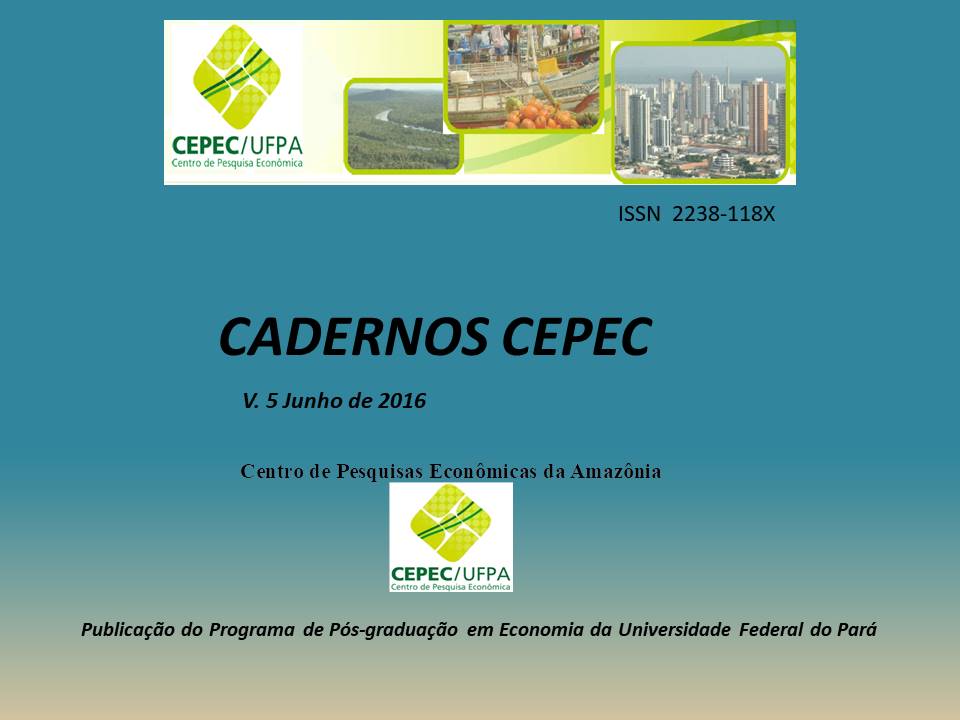Análise da Regulação da Conta de Capital
DOI :
https://doi.org/10.18542/cepec.v5i1-6.6896Mots-clés :
Conta de Capital, Liberalização Financeira, Regulação.Résumé
O artigo propõe uma análise crítica dos pontos positivos e negativos da liberalização financeira e ressalta as vantagens da regulação da conta de capital. À luz dessa discussão investigam-se alternativas recentes para se regular a conta de capital que possam mitigar os efeitos negativos promovidos pela liberalização dessa conta. Chega-se a conclusão de que para aumentar a estabilidade do sistema financeiro mundial, é crucial a tomada de medidas que reduzam não somente o volume do fluxo de capitais, mas também a velocidade com a qual ele é realizado contemporaneamente.Références
BIANCARELI, A. M. Financial Cooperation within the Context of South American Integration: Current Balance and Future Challenges. Integration & Trade, v. 15, n. 33, p. 17-25, 2011.
BROWNBRIDGE, M. e KIRKPATRICK, C. Financial Regulation in Developing Countries. The Journal of Development Studies, vol. 37, n. 1, p. 1-24, 2000.
CALVO, G. A., LEIDERMAN, L. e REINHART, C. M. Capital Inflows and Real Exchange Rate Appreciation in Latin America: The Role of External Factors. IMF Staff Papers, vol. 40, n. 1, p. 108-151, 1993.
CHANG, H. J. e GRABEL, I. Reclaiming Development: An Alternative Economic Policy Manual. London: Zed Books, 2004.
DYMSKI, G. A. O Gênio Fora da Garrafa: A Evolução da Política Too Big to Fail e a Estratégia Bancária dos Estados Unidos. In: CINTRA, M. e GOMES, K. (eds.) As Transformações no Sistema Financeiro Internacional. Brasília: Instituto de Pesquisa Econômica Aplicada (IPEA), p. 177-244, 2012.
EPSTEIN, G. e GRABEL, I. Financial Policies for Pro-Poor Growth: A Training Manual. Prepared for the United Nations Development Programme (UNDP). International Poverty Centre. Global Training Programme on Economic Policies for Growth, Employment and Poverty Reduction, 2007.
FRY, M. Money, Interest, and Banking in Economic Development. Baltimore: Johns Hopkins University Press, 1988.
GALLAGHER, K. P., GRIFFITH-JONES, S. e OCAMPO, A. J. Regulating Global Capital Flows for Long-Run Development. Boston: Boston University. The Frederick S. Pardee Center for the Study of the Longer-Range Future, 2012.
GHOSH, A., OSTRY, J. e TSANGARIDES, C. Shifting Motives: Explaining the Buildup in Official Reserves in Emerging Markets Since the 1980s. IMF Working Paper, n. 34, Washington, DC, 2012.
GOURINCHAS, P. O. e JEANNE, O. Capital Flows to Developing Countries: The Allocation Puzzle. National Bureau of Economic Research. Working Paper, n. 13602, 2007.
GRABEL, I. Ideology, Power, and the Rise of Independent Monetary Institutions in Emerging Economies. In: KIRSHNER, J. (ed.) Monetary Orders: Ambiguous Economics, Ubiquitous Politics. Ithaca: Cornell University Press, p. 25-52, 2003.
_______. Financial Systems and Economic Development in the 21st Century: Are we all Keynesian yet? In: ARESTIS, P. e SAWYER, M. (eds.) 21st Century Keynesian Economics. Palgrave Macmillan, 2010.
_______. The Rebranding of Capital Controls in an Era of Productive Incoherence. Political Economy Research Institute. Working Paper, n. 318, 2013.
HANSON, G. Should Countries Promote Foreign Direct Investment? UNCTAD G-24. Discussion Paper Series, n. 9, 2001.
HELLEINER, E. States and the Reemergence of Global Finance. Ithaca: Cornell University Press, 1996.
JEANNE, O., SUBRAMANIAN, A. e WILLIAMSON, J. Who Needs to Open the Capital Account? Peterson Institute Press: All Books, 2012.
KAPLAN, E. e RODRIK, D. Did the Malaysian Capital Controls Work? In: EDWARDS, S. e FRANKEL, J. (eds.) Preventing Currency Crises in Emerging Markets. Chicago: University of Chicago Press, 2001.
KING, R. e LEVINE, R. Finance and Growth: Schumpeter Might Be Right. Quarterly Journal of Economics, vol. 108, n. 3, p. 717-737, 1993.
KOSE, M. A., PRASAD, E. S. e TERRONES, M. E. Growth and Volatility in an Era of Globalization. IMF Staff Papers, vol. 52, p. 31-63, 2005.
KOSE, M. A. et al. Financial Globalization: A Reappraisal. National Bureau of Economic Research. Working Paper, n. 12484, 2006.
KRUGMAN, P. A Crise de 2008 e a Economia da Depressão. Rio de Janeiro. Elsevier, 2009.
LEVINE, R. Financial Development and Economic Growth: Views and Agenda. Journal of Economic Literature, vol. 35, p. 688-726, 1997.
MCKINNON, R. Money and Capital in Economic Development. Brookings Institution, 1973.
MISHKIN, F. S. Why We Shouldn't Turn our Backs on Financial Globalization. IMF Staff Papers, v. 56, n. 1, p. 139, 2009.
OCAMPO, J. A. Regional Financial Cooperation: Experiences and Challenges. In: _______ (ed.) Regional Financial Cooperation. Baltimore, MD. Brookings Institution Press, 2006.
_______. A Development-Friendly Reform of the International Financial Architecture. Politics & Society, v. 39, n. 3, p. 315-330, 2011.
OSTRY, J. D. Managing Capital Flows: What Tools to Use? Asian Development Review, vol. 29, n. 1, p. 83-89, 2012.
PALMA, G. The Three Routes to Financial Crises: The Need for Capital Controls. Schwartz Center for Economic Policy Analysis. Working Paper Series III, n. 18, New School University, New York, 2000.
RODRIK, D. The Social Cost of Foreign Exchange Reserves. International Economic Journal, vol. 2, n. 3, p. 253-266, 2006.
RODRIK, D. e SUBRAMANIAN, A. Why Did Financial Globalization Disappoint? IMF Staff Papers, vol. 56, n. 1, p. 112-138, 2009.
SCHULARICK, M. e STEGER, T. M. Financial Integration, Investment, and Economic Growth: Evidence from Two Eras of Financial Globalization. The Review of Economics and Statistics, vol. 92, n. 4, p. 756-768, 2010.
SHAW, E. S. Financial Deepening in Economic Development. New York: Oxford University, 1973.
SINGH, A. e WEISSE, B.A. Emerging Stock Markets, Portfolio Capital Flows and Long-Term Economic Growth: Micro and Macroeconomic Perspectives. World Development, vol. 26, n. 4, p. 607-622, 1998.
STIGLITZ, J. E. Financial Markets and Development. Oxford Review of Economic Policy, vol. 5, n. 4, p. 55-68, 1989.
_______. Capital Market Liberalization, Economic Growth, and Instability. World Development, vol. 28, n. 6, p. 1075-1086, 2000.
STUENKEL, O. The Financial Crisis, Contested Legitimacy, and the Genesis of Intra-BRICS Cooperation. Global Governance, vol. 19, n.4, p. 611-630, 2013.
SWEEZY, P. More (or Less) on Globalization. Monthly Review, vol. 49, n. 4, p. 1-4, 1997.
_______. Why Stagnation? Monthly Review, p. 69-77, 2004.
WILLIAMSON, J. e MAHAR, M. A Survey of Financial Liberalization. Essays in International Finance, n. 211. Princeton, New Jersey: International Finance Section, Economics Department, Princeton University, 1998.


